BREAKING: A bike rider is struck by a vehicle near 122nd and Division. Condition unknown. Will have updates shortly pic.twitter.com/f5dR4L0vyb
— Andrew Dymburt (@DymburtNews) June 22, 2017
Portland Police are responding to a serious injury collision that happened at the 2300 block of SE 122nd Avenue tonight.
The collision was between someone driving a car and a bicycle rider. The injuries to the bicycle rider have been described by police as “critical” and “traumatic.” The driver remained at the scene. No other details have been released.
On Tuesday morning, just one block away, a woman was hit and nearly killed while trying to cross 122nd at Division. The driver in that case fled the scene and was later arrested thanks to the work of witnesses who followed the man to his home and alerted authorities.
Advertisement
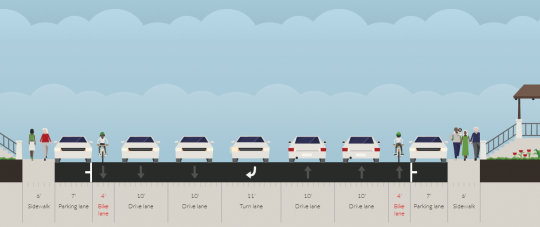
(Image: Streetmix.net)
122nd is a well-known by the City of Portland as a dangerous road. It’s an officially designated High Crash Corridor. According to ODOT crash data, the Division/122nd intersection is the fourth most dangerous intersection in Portland. PBOT’s Vision Zero Crash Map shows that there were 13 serious injury collisions at the intersection between 2005 and 2014.
The City of Portland has targeted 122nd Avenue for safety improvements in recent years, including $8 million for crossing and bus service upgrades in 2015.
We’ll share updates on tonight’s collision as they come in.
— Jonathan Maus: (503) 706-8804, @jonathan_maus on Twitter and jonathan@bikeportland.org
BikePortland is supported by the community (that means you!). Please become a subscriber or make a donation today.


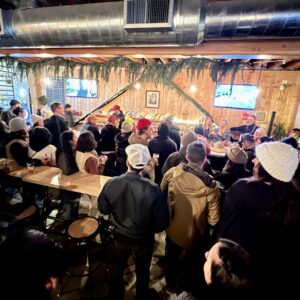
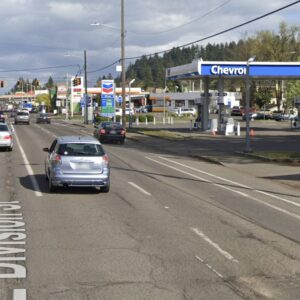

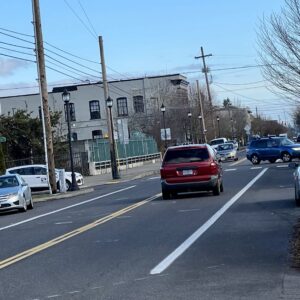
Thanks for reading.
BikePortland has served this community with independent community journalism since 2005. We rely on subscriptions from readers like you to survive. Your financial support is vital in keeping this valuable resource alive and well.
Please subscribe today to strengthen and expand our work.
We need to immediately implement bus-only* lanes on 122nd and Division (and every other wide arterial in the city). Take one motor vehicle lane and convert it to a bus-only lane; this could be implemented both cheaply and quickly. Bonus: take (often completely underutilized) parking lane and convert to buffered bike lane (upgrade to protected when funds can be acquired). All this would take is “no parking” signage and a little paint, and could be implemented tomorrow for relatively little cost. This isn’t hard, folks.
Interested in the concept? Check out:
– Portland Bus Lane Project (grassroots group) https://portlandb.us
– Enhanced Transit Corridors (PBOT project that’s just starting off and could use public support) https://www.portlandoregon.gov/transportation/73684
– “No More 4-Lane Roads!” BikeLoudPDX Pedalpalooza ride https://www.facebook.com/events/236797533475384
– PBOT’s Outer Division Safety Action Plan project (currently *does not* include bus-only lanes; please email/attend the June 29 open house and advocate for them!) https://www.portlandoregon.gov/transportation/article/621551
*would also need to allow for “right-turn only” movements, as well as emergency vehicles to make for a fast, no-fuss conversion, but that’s still way better than the status quo.
“We need to immediately implement bus-only* lanes on 122nd and Division (and every other wide arterial in the city). Take one motor vehicle lane and convert it to a bus-only lane;…..”
Good idea. Get Governor Brown and the Portland City Council to announce it right away; well, at least before the next election.
🙂
‘Immediately implement”
like magic?
You know, “immediately” in Municipal Time, 2-3 years, as opposed to “soon” (5-7 years) and “scheduled” (10-15 years).
Immediately in E Portland is more like 5-7 years.
Just wave your hand.
But seriously, we should be considering bus/bike lanes on all of the wide/fast east Portland streets. The parking is incredibly under-utilized, and a 12ft wide dedicated space would be significantly safer for cyclists and greatly speed up transit.
like?
https://bikeportland.org/2017/06/21/buses-at-forefront-as-pbot-unveils-enhanced-transit-corridors-plan-tonight-232271
You missed: Halsey, Glisan, 181st, and Division east of 82nd.
Here’s a report I put together for the Portland Bus Lane Project about bus only lanes on 122nd for the 73 bus – thought you might find some value in it, but the point is that that street is a nightmare (as everyone knows) and could be put to much better use:
https://docs.google.com/presentation/d/1AGZGuPK-BDcTGH2QCpoOnTSZhSXy8HZenr8VibfVSKI/edit#slide=id.p
I would like to know why the driver was not riding a bike. Hauling 4-6 bags of concrete, a precious antique lamp perhaps? 20 gallons of hot soup? I would like this to be a standard part of collision reports: why were you driving an automobile? This wouldn’t have happened if the driver had been on a bike instead.
Because it’s dark. I have over 30 years cycling and 70,000 miles and ZER0 AT NIGHT, 10 miles of a rando, one time.
I think is unwise to ride a bicycle at night. But I think it’s unwise to ride a bicycle in Portland. If you are going to advocate cycling in Portland you should stop all the griping and emphasize safer cycling. Experienced riders know how to avoid most common dangerous situations through best practices. The car hate helps no body.
Two people have been seriously hurt in that intersection in the last TWO DAYS. Redesigning outer Division is neither “griping” nor “car hate”, it is correcting a serious design flaw for which people are dying.
Congratulations on your 70,000 risk-free miles of cycling. With streets that are safer by design, we could all have that luxury. May you never have to cross a 7-lane road such as outer Division at night.
how does road design stop drunk drivers from running red lights?
it doesn’t, but it reduces the consequences…
I’ve answered this for you before, but OK. Here goes: You put some actual stuff in the actual street and the drunk/distracted/dead/absent/AI drivers crash into something that’s not a person!
Please. This guy. How long was he driving around, nearly-dead drunk? And didn’t hit anything? https://www.portlandoregon.gov/police/news/read.cfm?id=58172
Same thing for distracted drivers, soda choke event, runaway accelerator, autonomous vehicle misidentifies cyclist. Put something substantial between the metal things and the soft people. You can’t just tell people to “be careful” about a low-probability event and give them the same expanse of asphalt and paint you would where they drive 80mph. Give drivers some feedback of the consequences of their speed, starting with at least the risk of scratching their paint.
Generalities I get. People walking or biking on the side of the road can be further separated by space and barriers, but since bridges for pedestrian crossing paths have been shown ineffective, or particularly too expensive, I was curious about a specific solution for a road design that stops a deplorable driver from running a red light, as supposed by TS.
Saying stuff doesn’t make it possible. Criticism without solutions is less than helpful.
Even a modern roundabout would only slow such drivers close to the intersection, but not prevent entering drivers from crossing the crosswalks or entering the circle at an outrageous speed.
The point is that road design can do a lot, but not everything. VZ needs better roads, yes, but also better road users, better laws, better enforcement, better adjudication, better emergency response, etc.
No, not on the side of the road, *in* the road. For example, constricting both sides of each lane with posts or other obstacles at a turning lanes, etc. Competent drivers can reliably make it into an 8ft wide garage door opening, but they don’t do it at 60mph. Meanwhile on a street like 122nd, any vertical obstacles without a heartbeat are at least 80ft apart (and whenever somebody hits something, DOTs generally move it farther back.) Lowering standards and reduced enforcement won’t get us Vision Zero.
What an excellent idea — improving safety by purposely setting up dangers so people take things seriously. These ideas are especially practical for “vulnerable road users” who actually use roads since the traffic and normal road issues are too insignificant to prevent skills from atrophying to nothing. I especially like the idea of putting obstacles that hinder evasive maneuvers — we should stand tall and not retreat like cowards!
While we’re helping the drivers by putting obstacles for road users to hit, we could do the same for cyclists who are already traveling much more slowly and will have plenty of time to respond. And since so many ride without lights, make sure some of those obstacles in the path are dark. If unsafe behavior results in consequences, everyone will learn fast!
I would also point out the previous crash was a driver error driving on Division, while the current crash occurred on 122nd, north of Division. The first involved the intersection, but for the second that does not appear to be the case. Fixing Division would not have changed the conditions on 122nd.
Both streets are poorly designed, which PBOT has owned since 1990. They have had over 25 years to fix them. Fixing Division should encourage PBOT to fix 122nd, especially as they have already lined up $8 million to do so. I agree, a poorly designed street makes it easier for an impaired driver to get away with driving impaired. If traffic was slowed to 20 mph by design and engineering, an impaired driver would find it harder to go over 30 mph and kill or maim an unsuspecting user.
Only up to a certain point. see post 3(?) above.
“…Congratulations on your 70,000 risk-free miles of cycling. With streets that are safer by design, we could all have that luxury…” toadslick
Well he managed it…why can’t more people do so? Did he say “…risk-free…”? No. What he said was,
“…you should stop all the griping and emphasize safer cycling. Experienced riders know how to avoid most common dangerous situations through best practices. …” doug
And from my own experience, he’s correct in saying so. Biking anywhere motor vehicles are in use, is inherently dangerous, though it’s a danger that can be largely reduced through the use of safe, defensive biking practices. Sufficiently equipped for the varied situations encountered, riding at night can be safe, though as others elsewhere have said, night riding introduces special hazards like pavement problems, potholes, etc.
Riding at night just isn’t as much fun for me as riding in daylight, though there’s definitely something special about starting a ride in the dark on clear mornings to be on the road riding as the sun comes up.
I’ll be honest, this victim-blaming comment makes me angry, but I imagine it comes from a desperate need to justify why a serious crash won’t happen to you– something that unfortunately you can’t completely control, but that road and traffic design can influence.
So, best practices– it may be unwise to drive a car at night, if you can’t fulfill your obligation not to mow down other road users. If you are going to advocate driving in Portland you should stop all the excuses and emphasize safer driving.
FWIW, KOIN says the crash happened just after 9 p.m., and sunset was at 9:03.
And not everyone has the same amount of choice whether, when, or where they’ll be riding their bike.
nobody knows how/why it happened so the car blaming thing is pretty stupid as well.
I didn’t hear her spewing car hate. I thought grrlpup’s was an excellent post.
“…it may be unwise to drive a car at night, if you can’t fulfill your obligation not to mow down other road users. …” grrlpup
Sounds to me like an assumption before facts, that the person driving carelessly or recklessly ran over the person biking.
Is this “…car hate…”, or maybe just the tendency to generally conclude blame for collisions between people biking and people driving, upon the latter, that some people indulge in? I don’t know, but whatever it is, it doesn’t seem to much help people to stay focused on learning what circumstances unique to a particular collision, contributed to its happening.
In your mind—at least based on your comments here—your default assumption seems to be this:
in this collision the person driving drove in a responsible manner, and did what they could to avoid a collision with someone biking that wasn’t doing so in a responsible manner?
I’ll tell you what mine is:
The driver could have, through throttled speed and/or better attention or some combination of those, avoided or significantly reduced the severity of the collision. Period.
The part that is curious to me is that your assumption is entirely wishful, & not as far as I know based on any collision we have discussed here. But all the dozens of collisions I can recall discussing here bear out my approach.
really? how could you not?
Please describe how grrlpup’s comment blamed the car.
It’s easy to hear things that aren’t there when you have a bias. Like Black Lives Matter.
I didn’t hear any victim blaming, either.
What I mean to say, is that on the barest of details and facts available with the report of this collision having occurred, some people seem to have jumped to the conclusion that the person driving must have been negligent, careless or reckless for this collision to have happened. And that no way could the person biking have in any way been a primary cause of the collision.
Almost as if on cue it seems, some people seem to jump on the vacuum of available info about such collisions as an opportunity to heap animosity onto one or the other parties involved in the collision. I don’t think any good comes by this lack of self control. What if, once more details about it become known, it turns out that in this collision the person driving drove in a responsible manner, and did what they could to avoid a collision with someone biking that wasn’t doing so in a responsible manner?
Are the people here that already have jumped to using hot button rhetoric against people that drive, going to at least think about the inadvisability of what they’ve done? Cool heads are needed to deal with and resolve the range of problems that contribute to the occurrence of collisions. People from different perspectives need to put their heads together to do this successfully, and fanning the flames of animosity doesn’t help.
So cyclists run themselves over? No car = no crash. Stating this reality isn’t “car-blaming”, it’s just acknowledging that vehicles are the catalysts in making collisions violent.
THIS.
Actually, it appears that alcohol was likely to be the catalyst (at the very least a contributing factor) for this incident.
can you share what you know?
if alcohol is a factor, I’d still be inclined to think that what BradWagon wrote holds:
“vehicles are the catalysts in making collisions violent.”
Link to bikeportland story posted today, reporting more details on Wednesday’s collision:
https://bikeportland.org/2017/06/23/police-say-bike-rider-was-drunk-veered-out-of-bike-lane-before-collision-on-se-122nd-232591
Both vehicle operators, the person driving, and the person riding, apparently made some mistakes that contributed to the occurrence of the collision. This weblog writes:
“…Omar was riding his bicycle southbound on 122nd Avenue approaching Division when police say he, “Veered out of the bike lane and collided with Duffus’ vehicle causing him to crash.” …”.
The person driving fouled up too. Read more about that in the linked story. Wasn’t reported as DUI, but considering the citations issued to the driver, I have to wonder some about the general physical and mental fitness of this person to be driving. Also about the manner of driving leading up to the collision, for example, mph speed traveled.
https://www.youtube.com/watch?v=Op14XhETfBw
I have more night miles than you have miles (not surprising since I have an order of magnitude more miles than you). I find your fear of night riding misinformed at best. Sure, I’ve been struck by motorists and had some close calls. None of those incidents have happened at night.
I should think it is obvious that night riding is safer for two reasons: There is less traffic and one can easily stand out against the background with lights and reflectors. Sure, 9:00 to midnight does see a high percentage of the cyclists struck down, but that appears to be related to intoxicated ninja riding, not any inherent dangers of night riding for those who would choose to light up a bit.
Agreed. I’ve ridden many tens of thousands of miles at night, most of it along rural 2 lane highways, and consider it safer than riding in bright sunlight.
Decent lighting and reflective gear make you far more visible than you can be in daylight.
Cars aren’t a special threat at night, but debris, holes, etc. are.
My dark rides into work at 5am are significantly safer than my rides home at 3pm. I would argue that the time just before sunrise is the absolute safest time to be on the roads. The drunks have all gone to bed, and most of the vehicles on the road are focused on getting to work.
Totally agreed here. In the 5-6am timeframe, the road vibe is totally different. There are way fewer cars, early risers tend to be far more relaxed than other drivers, and the drunks are gone. That’s probably my favorite time to be out.
By the time you’re in regular commuting hours, there is a lot more traffic and it’s much more aggressive because half of them are late.
In the evening, everyone is tired and not as attentive. On Friday evenings, the driving gets noticeably loonier after what I call the “Happy Hour effect.”
I started leaving work around 3pm to avoid the 5pm happy hour drivers I was encountering in the Pearl.
not surprising since I have an order of magnitude more miles than you – (B. Carfree)
You’ve ridden 700,000 miles? If I live to be 100 and ride over an hour every single day I’d be lucky to match you! Honestly, I’d be pleased if I ever rode 7k in any single year, much less 100 years in a row. I’m so far from worthy it’s pathetic!
Yesterday was the longest day of the year, and was definitely NOT dark at 9pm. Dusk was starting, and it really didn’t get “dark” until about 9:45.
Maybe they have a disability.
And they just had to be out at night? Don’t they know it’s unwise to drive at night?
or ride your bike drunk on a busy street.
Not everyone can ride a brakeless fixie while hauling a couple bags of concrete. Obviously Amanda. And yet a person who is able to safely operate a car might be able to use some of our advanced 2017 technology to move through a city without dragging one or more tons of metal along. But keep making excuses for the vast majority of people who used to be able-bodied but chose to sit in a car instead of making the effort to wear a hat when it rains.
“Why were you riding a bicycle?”
This wouldn’t have happened if the cyclist was walking instead.
See – easy to to do and sounds just as ridiculous.
Pedestrian struck by car happens all the time, and critical injury would be typical in that case as well. So, not as easy as you think. Ridiculous is ignoring the role played by a couple tons of metal.
You mean like failing to notice that one might be on a collision course with a huge, noisy, and highly visible chunk of metal moving in a space specifically designated for that purpose?
Crossing a road where the vehicles are moving 70mph is easy, provided that you have time to complete the crossing with a reasonable margin from where you can see the vehicles.
The auto zombies march forward, devouring their victims on their endless quest to consume the resources of the earth and fill the skys with their effluent. Will this only end when the last drop of oil has been sucked from the ground and the seas have covered the great cities? As Longfellow said, ” Whom the gods would destroy they first make mad.”
You are very melodramatic.
Thanks,
Plus, this poet said it better. We will always move toward our end. No stopping it.
https://www.youtube.com/watch?v=hRc6mHS9PjE
It seems that you believe that calling people names for the mode of transportation they use to get around either by obligation or choice, somehow helps to reduce or hopefully even eliminate collisions from happening. Maybe you can explain how people calling each other names, does anything more than have them bickering and squabbling to no good end with each other.
For everyone’s benefit, you might consider saving the name calling for muttering over your beer or beverage of choice, as you dally around on your chair, hopefully spending at least some time seriously mulling over the difficult dilemma of trying to arrive at providing a road system which everyone can use to meet their travel needs with the mode they need to use it with, and which is able to avoid having collisions occurring on them.
I think future generations will have much worse names for those who were still promoting and defending the widespread use of personal petroleum fueled transport in the year 2017 than auto zombies.
With some luck, future generations will have more people, smart enough to direct their energies to coming up with real answers to real transportation challenges facing a growing population, rather than indulging in name calling.
The configuration of streets today, largely for motor vehicle use, and people’s predominant use of them with motor vehicles, is not due so much to the majority public promoting and defending use of motor vehicles, if that’s whom you are directing your name calling to. Over decades, street design has evolved to the configuration it is today as a response to meeting the travel needs of a great many people that have no other real option than travel by motor vehicle.
“Over decades, street design has evolved to the configuration it is today as a response to meeting the travel needs of a great many people that have no other real option than travel by motor vehicle.”
Well, that’s a chicken/egg scenario that could be debated. Did people lose choices because that’s what they chose, or were choices slowly removed, streets redesigned, and laws passed such that cars were favored and “promoted” in so many built-in ways that it didn’t even look like promotion?
For definition of Auto Zombie look in dictionary under Portland Business Alliance, or see Bike Portlands latest article.
Pay special attention to the comments section for ideas authored by people presenting themselves as bike advocates.
Many of them appear to find the idea of bikes on roads with cars more objectionable than any drivers I know.
The police statement didn’t lay out reasons to blame the cyclist or excuse the driver this time. Nothing about high-viz, no mention of a helmet, the driver stayed but no mention of being “cooperative.”
So…progress, I guess?
I like to group most crashes as “car violence” since most can’t drive worth a sh%t these days and distracted. be safe and enjoy the ride!
Am I reading this pyramid incorrectly?
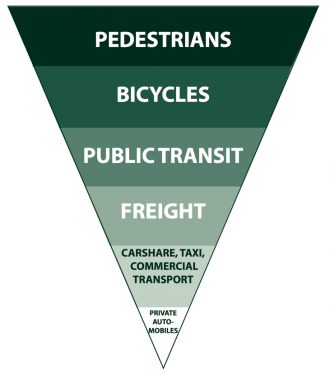
Unfortunately. Here’s another head scratcher:
Ted that is the old ODOT and PBOT transportation priority chart from the 50’s. The last time I saw it, horses were between pedestrians and cyclists.
And flying cars seem to have been completely omitted.
you misspelled “electric bikes”
I bike that segment pretty frequently and the bike lane is atrocious. I’ve had a few close calls, but the most memorable was when I almost got pinched between a panel truck that was parked and encroaching the bike lane and a city water bureau dualie truck that encroached from the auto lane to make a right turn (so they almost squished me twice.)
Hey –
It’s been a long time! Welcome back.
“…65 feet cross-section of roadway and and only 4 feet of it afforded to a bicycle lane in either direction (8 feet total), squeezed between a door zone and cars undoubtably breaking 45 mph. …” lascurettes
Main travel lanes used mostly with motor vehicles, are 10′ wide. The largest percentage of this road’s width is dedicated to providing lane width sufficient for use of the road with motor vehicles because it’s that mode of travel by which most people on this road likely traveling by.
Of course, as needed, people biking are entitled to use all lanes of almost every road in the state including this one. Looking at the numbers might help to determine whether the road’s width being apportioned for lanes sufficient to be used with motor vehicles, is reasonable for this road: What’s daily vehicle numbers for this road, motor vehicle and bikes, and particularly during commute hours?
By the way, what is the posted speed limit for this road? If it’s a 35 or 40 mph road, some thought could be given to achieving safer use of the road by trying to persuade to have it posted for 25 or 20 mph.
Any Updates on this 122 bike being mowed down near Division. That was June 21st.
On June 22nd a woman on a bike was mowed down. Hit and Run at 80th and SE pine
https://www.gofundme.com/weloveyouerin
Where is the outrage? Why is PBOT and the Mayor and PBOT commissioner not tweeting out looking for the Hit and Run driver?
Wheeler is too busy pandering to the special interest group of the day.